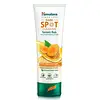What's inside
What's inside
 Key Ingredients
Key Ingredients

 Benefits
Benefits

 Concerns
Concerns

 Ingredients Side-by-side
Ingredients Side-by-side

Water
Skin ConditioningAmmonium Lauryl Sulfate
CleansingCocamidopropyl Betaine
CleansingGlycerin
HumectantAcrylates/C10-30 Alkyl Acrylate Crosspolymer
Emulsion StabilisingSodium Cocoyl Glutamate
CleansingDisodium Cocoyl Glutamate
CleansingPhenoxyethanol
PreservativeParfum
MaskingSodium Chloride
MaskingSodium Hydroxide
BufferingNiacinamide
SmoothingEthylhexylglycerin
Skin ConditioningDisodium EDTA
Tocopheryl Acetate
AntioxidantGlycolic Acid
BufferingCurcuma Longa Rhizome Extract
Skin ConditioningGlycyrrhiza Glabra Root Extract
BleachingCI 19140
Cosmetic ColorantCI 15985
Cosmetic ColorantWater, Ammonium Lauryl Sulfate, Cocamidopropyl Betaine, Glycerin, Acrylates/C10-30 Alkyl Acrylate Crosspolymer, Sodium Cocoyl Glutamate, Disodium Cocoyl Glutamate, Phenoxyethanol, Parfum, Sodium Chloride, Sodium Hydroxide, Niacinamide, Ethylhexylglycerin, Disodium EDTA, Tocopheryl Acetate, Glycolic Acid, Curcuma Longa Rhizome Extract, Glycyrrhiza Glabra Root Extract, CI 19140, CI 15985
Water
Skin ConditioningKaolin
AbrasiveMelia Azadirachta Leaf Extract
Skin ConditioningPropylene Glycol
HumectantBentonite
AbsorbentFuller's Earth
AbrasiveCurcuma Longa Root Extract
MaskingParfum
MaskingSodium Methylparaben
PreservativeImidazolidinyl Urea
PreservativeDMDM Hydantoin
PreservativeXanthan Gum
EmulsifyingDisodium EDTA
Sodium Propylparaben
PreservativeCitric Acid
BufferingSodium Lauryl Sulfate
Cleansing
 Reviews
Reviews

Ingredients Explained
These ingredients are found in both products.
Ingredients higher up in an ingredient list are typically present in a larger amount.
Disodium EDTA plays a role in making products more stable by aiding other preservatives.
It is a chelating agent, meaning it neutralizes metal ions that may be found in a product.
Disodium EDTA is a salt of edetic acid and is found to be safe in cosmetic ingredients.
Learn more about Disodium EDTAParfum is a catch-all term for an ingredient or more that is used to give a scent to products.
Also called "fragrance", this ingredient can be a blend of hundreds of chemicals or plant oils. This means every product with "fragrance" or "parfum" in the ingredients list is a different mixture.
For instance, Habanolide is a proprietary trade name for a specific aroma chemical. When used as a fragrance ingredient in cosmetics, most aroma chemicals fall under the broad labeling category of “FRAGRANCE” or “PARFUM” according to EU and US regulations.
The term 'parfum' or 'fragrance' is not regulated in many countries. In many cases, it is up to the brand to define this term.
For instance, many brands choose to label themselves as "fragrance-free" because they are not using synthetic fragrances. However, their products may still contain ingredients such as essential oils that are considered a fragrance by INCI standards.
One example is Calendula flower extract. Calendula is an essential oil that still imparts a scent or 'fragrance'.
Depending on the blend, the ingredients in the mixture can cause allergies and sensitivities on the skin. Some ingredients that are known EU allergens include linalool and citronellol.
Parfum can also be used to mask or cover an unpleasant scent.
The bottom line is: not all fragrances/parfum/ingredients are created equally. If you are worried about fragrances, we recommend taking a closer look at an ingredient. And of course, we always recommend speaking with a professional.
Learn more about ParfumWater. It's the most common cosmetic ingredient of all. You'll usually see it at the top of ingredient lists, meaning that it makes up the largest part of the product.
So why is it so popular? Water most often acts as a solvent - this means that it helps dissolve other ingredients into the formulation.
You'll also recognize water as that liquid we all need to stay alive. If you see this, drink a glass of water. Stay hydrated!
Learn more about Water